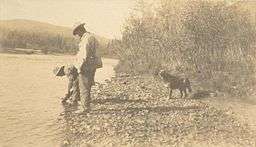Thomas Fisher Rare Book Library

The Thomas Fisher Rare Book Library is a library in the University of Toronto, constituting the largest repository of publicly accessible rare books and manuscripts in Canada. The library is also home to the university archives which, in addition to institutional records, also contains the papers of many important Canadian literary figures including Margaret Atwood and Leonard Cohen.
Richard Landon, the director until his death in 2011,[1] organized two or three exhibitions of rare books and other materials annually.
The Department of Rare Books and Special Collections was founded in November 1955 by the Chief Librarian, Robert H. Blackburn. Blackburn hired Marion E. Brown who was working in the special collections department at Brown University. Brown's first responsibility was to deal with the items that had been accumulating since 1890. Some of these items in the collection included medieval manuscripts, early printed books, and special volumes of later periods that had been presented by Queen Victoria to the University. Between the accumulated items and items found in the stacks of the main library, there was enough to open up the Rare Book Room in 1957.[2]
The Department of Rare Books and Special Collections and the University Archives didn't have a permanent home until 1973 when the Thomas Fisher Rare Book library was opened. The library is named in honour of Thomas Fisher (1792–1874) who immigrated from Yorkshire settled along the Humber River in 1822 and became a successful merchant-miller. In 1973 his great-grandsons, Sidney and Charles Fisher, donated to the library their own collections of Shakespeare, various twentieth-century authors, and etchings of Wenceslaus Hollar.
The Fisher building was designed by Mathers and Haldenby, Toronto with design consultant Warner, Burns, Toan and Lunde, New York. It forms part of a complex with the John P. Robarts Research Library for the Humanities and Social Sciences, and the Claude Bissel Building which houses the Faculty of Information.[3]
Collections
Among the collection's items are the Nuremberg Chronicle (1493), Shakespeare's First Folio (1623), and Newton's Principia (1687). Contrary to widespread internet claims [4] ,[5] the library does not have Darwin's proof copy with annotations of On the Origin of Species (1859); the library does however have annotated proof sheets of: The Power of Movement in Plants ,[6] The Expression of the Emotions in Man and Animals ,[7] and The Effects of Cross and Self Fertilisation in the Vegetable Kingdom .[8] Other collections include Babylonian cuneiform tablet from Ur (1789 BC), 36 Egyptian papyrus manuscript fragments (245 BC), and Catholicon (1460).[9]
The Robert S. Kenny Collection resides in the library. This immense collection of books, documents, and other materials pertaining to the radical and labour movements, particularly in Canada, contains approximately 25,000 items collected by Robert S. Kenny, who was a member of the Communist Party of Canada. The Canadian section, which has 382 books and 768 pamphlets, was acquired by the library from Kenny in 1977. The international section of the collection was donated by Kenny in 1993.
In addition, there is an outstanding collection of etchings by Wenceslaus Hollar (1607–1677) from the collection of Sidney Thomson Fisher. The collection has been digitized and is a remarkable historical resource.
Gallery
.jpg)
 Panning for gold on the Indian River, 1904; photo by Joseph Tyrrell
Panning for gold on the Indian River, 1904; photo by Joseph Tyrrell
References
- ↑ "Obituary for Richard Landon (1942-2011), Director of Thomas Fisher Rarebooks Library, University of Toronto".
- ↑ Thomas Fisher Rare Book Library. "Brief History of the Department". Retrieved 3 September 2013.
- ↑ Thomas Fisher Rare Book Library. "Brief History of the Department". Retrieved 3 September 2013.
- ↑ "Thomas Fisher Rare Book Library". Wikicollecting. Retrieved 2014-07-22.
- ↑ "Allan's Library: An Academic Viewpoint". Retrieved 2014-07-22.
- ↑ "The power of movement in plants [proof sheets] / University of Toronto Libraries". University of Toronto. Retrieved 2014-07-22.
- ↑ "The Expression of the Emotions in Man and Animals [proof sheets] / University of Toronto Libraries". University of Toronto. Retrieved 2014-07-22.
- ↑ "The Effects of Cross and Self Fertilisation in the Vegetable Kingdom [proof sheets] / University of Toronto Libraries". University of Toronto. Retrieved 2014-07-22.,
- ↑ "Thomas Fisher Rare Book Library Collections". University of Toronto. Retrieved 2008-08-15.
External links
| Wikimedia Commons has media related to Thomas Fisher Rare Book Library. |
Coordinates: 43°39′50.5″N 79°23′56.3″W / 43.664028°N 79.398972°W
